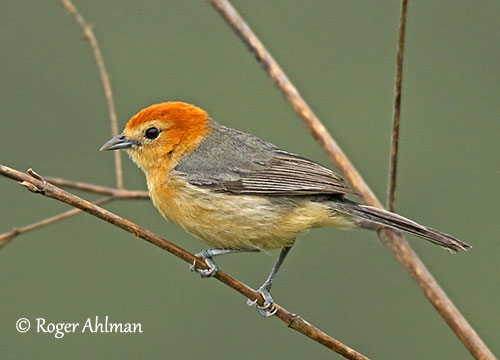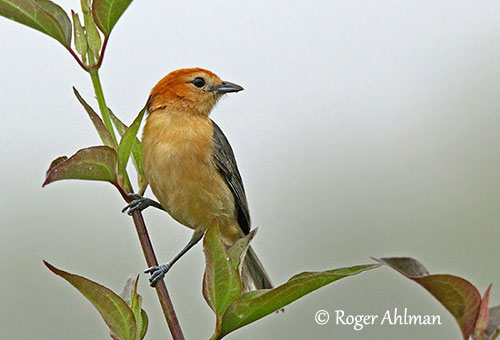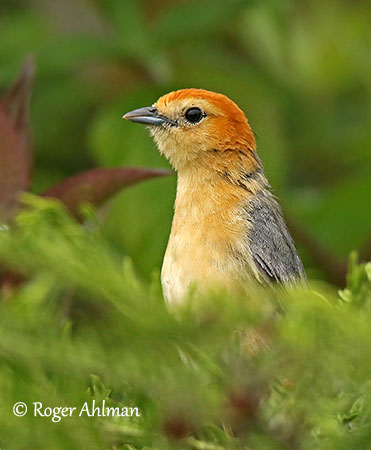
Fr: Tangara à ventre roux
Ang: Buff-bellied Tanager
All: Braunbauchtangare
Esp: Tangara Sencilla
Pérou: Tangara de Vientre Anteado
Ita: Tanagra panciacamoscio
Nd: Taanbuiktangare
Sd: beigebröstad tangara
Photographer:
Roger Ahlman
Pbase Galleries Peru and Ecuador & My bird pictures on IBC
Text by Nicole Bouglouan
Sources:
HANDBOOK OF THE BIRDS OF THE WORLD Vol 16 by Josep del Hoyo- Andrew Elliot-David Christie – Lynx Edicions – ISBN: 9788496553781
TANAGERS: Natural History, Distribution and Identification (Helm Identification Guides) - By Morton L. Isler and Phyllis R. Isler - Christopher Helm Publishers Ltd; New edition (30 April 1999) - ISBN-10: 0713651164
BIRDS OF PERU by Thomas S. Schulenberg, Douglas F. Stotz, Daniel F. Lane, John P. O’Neill, Theodore A. Parker III – Princeton University Press 2007 – ISBN: 978-0-691-13023-1
BIRDS OF SOUTH AMERICA – Passerines - by Robert S. Ridgely and Guy Tudor – HELM Field Guides – ISBN: 9781408113424
Fatbirder - Thraupidae - Tanagers & Allies
Neotropical Birds – Cornell Lab of Ornithology
Wikipedia, la enciclopedia libre
Home page
Page Passeriforme Order
Buff-bellied Tanager
Thlypopsis inornata
Passeriformes Order – Thraupidae Family
INTRODUCTION:
The Buff-bellied Tanager is a member of the genus Thlypopsis with five other species. This genus resembles the Parulidae, the New World warblers, in appearance and behaviour.
This species occurs in deciduous woodland, shrubby clearings and forest borders from 450 to 1,800/2,000 metres of elevation in extreme SE Ecuador and NW Peru. It feeds mainly on small arthropods and forages in pairs of in small family groups.
The Buff-bellied Tanager has currently stable population and the species is described as “fairly common”.
DESCRIPTION OF THE BIRD:
Biometrics:
Length: 13 cm
Weight: 14-17 g
The Buff-bellied Tanager male has olive-grey upperparts including back, rump and uppertail-coverts. On the upperwing, the coverts are olive-grey with brownish wash, whereas the primary coverts are dusky. The flight-feathers are dusky too, with narrow greyish-olive edges to outer feathers. Inner feathers are mostly edged and washed brownish. The tail is olive-grey washed brownish.
Throat and underparts are pale orange-buff, but centre of belly and undertail-coverts are whitish with buff tinge.
On the head, crown and nape are dark cinnamon-rufous, becoming uniformly buff on face where forming a broad supercilium.
The bill is greyish-black with paler and bluer lower mandible. The eyes are dark brown. Legs and feet are bluish-grey.

The female is duller than male, especially on crown and nape, with less contrast with the upperparts. Ear-coverts are more cinnamon, whereas rest of face and underparts are buff with pale orange wash.
The immature resembles female but it has mostly greyish-olive upperparts and yellowish underparts.
RANGE:
The Buff-bellied Tanager is found in extreme SE Ecuador and NW Peru (Amazonas and Cajamarcas in drainage of upper Río Marañon).
HABITAT:
The Buff-bellied Tanager frequents dry, shrubby, semi-arid second growth, dry forest, dry scrub and brush along rivers and in ravines, and forest edges.
It can be seen from 450 to 2,000 metres of elevation in Peru, and between 650 and 1,200 metres in SE Ecuador.
CALLS AND SONGS: SOUNDS BY XENO-CANTO
The Buff-bellied Tanager gives “sip” or “seep” calls while foraging in groups.
The song is a series of high-pitched “seer” and “seek” notes given in variable combinations. It also produces a softly repeated “seet-a”.
BEHAVIOUR IN THE WILD:
The Buff-bellied Tanager feeds primarily on small arthropods. It forages usually low in woodland borders, and can be seen in tall grass and small shrubs. It also gleans in foliage, often small Acacia leaves on outer branches, and probes flowers.
It usually occurs in pairs or in small family groups of 4-5 individuals. They forage at various heights but also close to the ground, and sometimes up in tree canopy in dry woodland.

The breeding habits of the Buff-bellied Tanager are unknown. The breeding system is usually monogamous in most tanager species.
The Buff-bellied Tanager is apparently resident in its range.
The wing shape reflects the sedentary status of the species and the lack of aerial foraging. However, they are good fliers and are able to fly rapidly between resting and nesting areas to feeding places.
REPRODUCTION OF THIS SPECIES:
There is no information on breeding and nesting behaviour of this species.
The breeding season usually occurs when food is available and abundant, usually September/October in South America.
The nests of other species of genus Thlypopsis are often cup-shaped and built on branches in trees. The clutch may contain 3-5 eggs incubated by the female, fed by the male during this period. The young are fed by both parents.
PROTECTION / THREATS / STATUS:
The Buff-bellied Tanager has restricted range where it is uncommon to locally fairly common. It is threatened by habitat loss through conversion of habitats to agriculture, but only in a few areas.
The population is suspected to be stable and not globally threatened. The Buff-bellied Tanager is currently evaluated as Least Concern.
